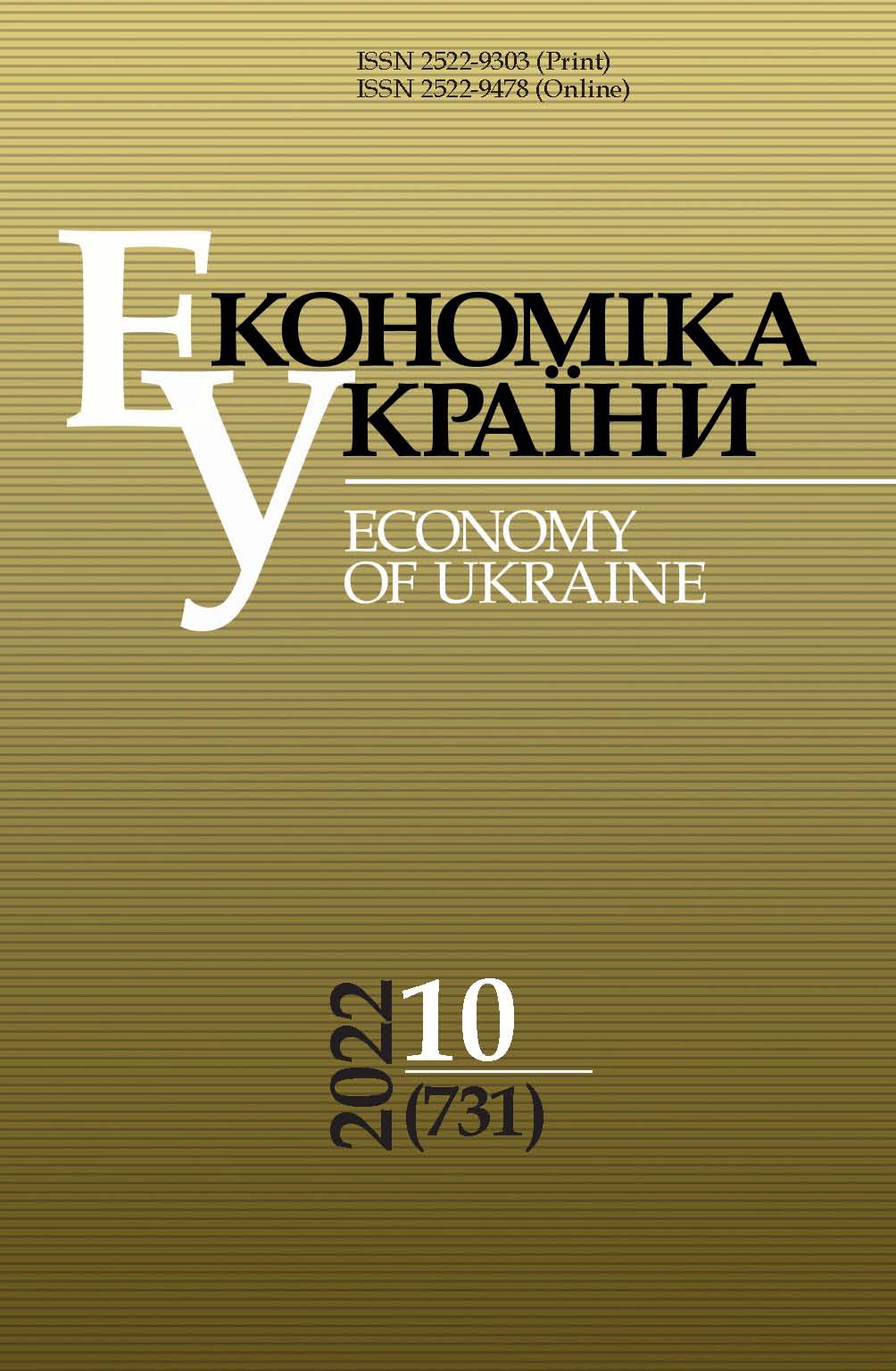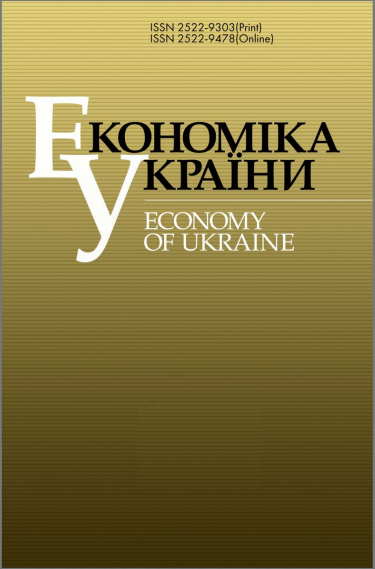POST-WAR INFLATION TARGETING: KEY CHALLENGES
DOI:
https://doi.org/10.15407/economyukr.2022.10.015Keywords:
inflation targeting, monetary policy, National Bank of Ukraine, interest rates, monetary transmission, foreign exchange reservesAbstract
The National Bank of Ukraine (NBU) suspended inflation targeting for the period of martial law, but announced a return to it as soon as the situation allows. The post-war normalization of monetary policy in Ukraine is historically unprecedented, since most of the known cases involve the relaunch of money circulation and the adjustment of banking activities, the establishment of the central bank as an institution designed to eliminate the macroeconomic preconditions of internal conflicts. At the same time, military conflicts are characterized by monetary financing of the budget, a spike in inflation and increased dollarization, and seigniorage may be the optimal form of compensation for a sudden loss of tax revenues only to a limited extent.
The restoration of inflation targeting in Ukraine will face a number of general macroeconomic challenges such as: acceleration of inflation, delay in the adjustment of non-core inflation components, uncertainty regarding the volume of monetary financing of the deficit after the end of martial law; degradation of monetary transmission; decline in inflation expectations and likely strengthening of pass-through effects. However, these challenges are more likely to affect the timing of return to inflation targeting. From a technical point of view, this process will encounter problems related to: specification of the inflation target (new "sloping" corridor, actualization of the old target in various forms); probable optimal decrease in its level due to European integration; decline in the criterion values of GDP gap and the level of neutral rate when assessing the monetary policy stance; resuming the accumulation of foreign exchange reserves with the corresponding continuation of the tendency to maintain the liquidity structural surplus. The independence of the NBU will play a key role in neutralizing the credibility problem in the face of potential alternative between the speed of inflation stabilization and the acceleration of economic recovery.
References
Collier P. On the Economic Consequences of Civil War. Oxford Economic Papers, 1999, Vol. 51, Iss. 1, pp. 168-183.
doi.org/10.1093/oep/51.1.168
Collier P., Hoeffler A. Greed and Grievance in Civil War. Oxford Economic Papers, 2004, Vol. 56, Iss. 4, pp. 563-595.
doi.org/10.1093/oep/gpf064
Rooden van R., Dicks-Mireaux L. Monetary and Exchange Rate Policy in a Post-Conflict Environment. Ch. 5. In: Reconstructing Afghanistan. A. Bennett (Ed.). IMF. Wash. (D.C.), 2005, pp. 59-71.
Makdisi R., Soto R. Economic Agenda for Post-Conflict Reconstruction. ERF Working Papers Series, 2020, No. 1395, available at: erf.org.eg/app/uploads/2020/08/1598531136_133_452682_1395.pdf
Starr M. Monetary Policy in Post-Conflict Countries: Restoring Credibility. American University. Washington (D.C.). Department of Economics. Working Paper Series, 2004, No. 2004-07, available at: w.american.edu/cas/economics/repec/amu/workingpapers/2004-07.pdf
Adam Ch., Coller P. Postconflict Monetary Reconstruction. The World Bank Economic Review, 2008, Vol. 22, Iss. 1, pp. 87-112.
doi.org/10.1093/wber/lhm020
Diallo O., Loris Gui-Diby S., Imam P.A. Do Monetary Policy Outcomes Promote Stability in Fragile Settings? IMF Working Papers, 2022, May 20, available at: www.imf.org/en/Publications/WP/Issues/2022/05/20/Do-Monetary-Policy-Outcomes-Promote-Stability-in-Fragile-Settings-518203
Bruno M., Fischer S. Seigniorage, operating rules and the high inflation trap. Quarterly Journal of Economics, 1990, Vol. 105, Iss. 2, pp. 353-374.
doi.org/10.2307/2937791
Calvo G., Leiderman L. Optimal inflation tax under precommitment: theory and evidence. American Economic Review, 1992, Vol. 82, No. 1, pp. 179-194, available at: www.jstor.org/stable/2117609
Calvo G., Guidotti P. On the flexibility of monetary policy: the case of the optimal inflation tax. Review of Economic Studies, 1993, Vol. 60, Iss. 3, pp. 667-687.
doi.org/10.2307/2298130
Mankiw G. The optimal collection of seigniorage: theory and evidence. Journal of Monetary Economics, 1987, Vol. 20, Iss. 2, pp. 327-341, available at: www.sciencedirect.com/journal/journal-of-monetary-economics/vol/20/issue/2
doi.org/10.1016/0304-3932(87)90019-5
Collier P., Hoeffler A. Aid, Policy and Growth in Post-Conflict Societies. European Economic Review, 2004, Vol. 48, Iss. 5, pp. 1125-1145, available at: www.sciencedirect.com/journal/european-economic-review/vol/48/issue/5
doi.org/10.1016/j.euroecorev.2003.11.005
Collier P., Hoeffler A. Unintended Consequences: does Aid Finance Military Spending? Oxford Bulletin of Economics and Statistics, 2007, Vol. 69, No. 1, pp. 1-27.
doi.org/10.1111/j.1468-0084.2006.00439.x
Becker T., Eichengreen B., Gorodnichenko Y. et al. Macroeconomic Policies for Wartime Ukraine. CEPR. London, CEPR Press, 2022.
Hu Y. The Choice of Inflation Targeting -- An Empirical Investigation. International Economics and Economic Policy, 2006, Vol. 3, Iss. 1, pp. 27-42, available at: link.springer.com/journal/10368/volumes-and-issues/3-1
doi.org/10.1007/s10368-005-0044-y
Schmidt-Hebbel K., Carrasco M. The Past and Future of Inflation Targeting. In: Monetary Policy in India, 2016, pp. 583-622.
doi.org/10.1007/978-81-322-2840-0_18
Ismailov Sh., Kakinaka M., Miyamoto H. Choice of Inflation Targeting: Some International Evidence. The North American Journal of Economics and Finance, 2016, Vol. 36, Iss. C, pp. 350-369.
doi.org/10.1016/j.najef.2016.03.001
Batini N., Laxton D. Under What Condition Can Inflation Targeting Be Adopted? The Experience of Emerging Markets. In: Monetary Policy under Inflation Targeting. F. Mishkin, N. Loayza, K. Schmidt-Hebbel (Eds.). Santiago, Central Bank of Chile, 2007, pp. 467-506.
Gregorio J. Commodity Prices, Monetary Policy and Inflation. Paper Presented for the Conference on Policy Responses to Commodity Price Movements, organized by IMF and Central Bank of Turkey, April 2012.
doi.org/10.1057/imfer.2012.15
Agenor P.-R., Pereira da Silva L. Inflation Targeting and Financial Stability: A Perspective from Developing World. IDB, 2013, available at: www.cemla.org/PDF/IADB-CEMLA-InflationTargeting.pdf
Gelos G., Ustyugova Y. Inflation Responses to Commodity Price Shocks -- How and Why Do Countries Differ? IMF Working Papers, 2012, WP/12/225, available at: www.imf.org/external/pubs/ft/wp/2012/wp12225.pdf
doi.org/10.5089/9781475510249.001
Airaudo M., Buffie E., Zanna L.-F. Inflation Targeting and Exchange Rate Management in Less Developed Countries. IMF Working Papers, 2016, WP/16/55, available at: www.imf.org/external/pubs/ft/wp/2016/wp1655.pdf
doi.org/10.5089/9781513567433.001
Flood R., Marion N. Perspectives on the Recent Currency Crisis Literature. IMF Working Papers, 1998, WP/98/130, available at: www.imf.org/external/pubs/ft/wp/wp98130.pdf
doi.org/10.5089/9781451855166.001
Svensson L. Optimal Inflation Targeting: Further Developments of Inflation Targeting. In: Monetary Policy under Inflation Targeting. F. Mishkin, N. Loayza, K. Schmidt-Hebbel (Eds.). Santiago, Central Bank of Chile, 2007, pp. 187-225.
Downloads
Published
How to Cite
Issue
Section
License
Copyright (c) 2022 Institute for Economics and Forecasting of the NAS of Ukraine

This work is licensed under a Creative Commons Attribution-NonCommercial-NoDerivatives 4.0 International License.



